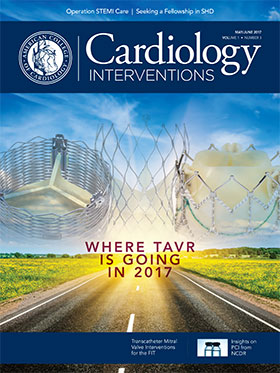Peripheral Matters: Guideline-Recommended Prevention and Lifestyle Counseling Underused in PAD Patients
Fewer than half of patients with peripheral artery disease (PAD) in the United States (U.S.) receive guideline-recommended secondary prevention and lifestyle counseling to reduce the risk of cardiovascular events says new research published in the Journal of the American College of Cardiology. The study explores the trends in medical therapy and lifestyle counseling for U.S. patients with PAD between 2006 and 2013.
Using data from the National Ambulatory Medical Care Survey and the National Hospital Ambulatory Medical Care Survey, Jeffrey S. Berger, MD, FACC, and Joseph A. Ladapo, MD, PhD, evaluated trends in the proportion of office visits with medication use and lifestyle counseling among patients with diagnosed PAD. Medication used was defined to include antiplatelet therapy, statins, angiotensin-converting enzyme inhibitors (ACEIs), angiotensin-receptor blockers (ARB) or cilostazol. Lifestyle counseling was defined as exercise or diet counseling and smoking cessation.
Overall results found that over the eight-year study period, the average number of ambulatory visits in the U.S. was 3,883,665; the mean age was 69.2 years. Comorbid coronary artery disease was present in 24.3 percent of visits. The authors note “the proportion of visits reporting use of medical therapy and lifestyle counseling was low and appears suboptimal in consideration of the substantial benefit of secondary cardiovascular prevention and lifestyle counseling.”
Any antiplatelet therapy was used in only 35.7 percent of visits, followed by statin use in 33.1 percent, ACEI or ARB in 28.4 percent and cilostazol in 4.7 percent. Exercise or diet counseling was used in only 22 percent of visits, while smoking cessation counseling or medication use occurred in 35.8 percent of visits for current smokers. Patients with comorbid coronary artery disease were more likely to be prescribed antiplatelet therapy (odds ratio [OR], 2.6; 95 percent confidence interval [CI], 1.8-3.9), statins (OR, 2.6; 95 percent CI, 1.8-3.9), ACEI/ARB (OR, 2.6; 95 percent CI, 1.8-3.9) and smoking cessation counseling (OR, 4.4; 95 percent CI, 2.0-9.6).
The results were much lower than expected, highlighting an opportunity to improve the quality of care in these high-risk patients, conclude Berger and Ladapo. They suggest that investments in new health care system strategies are required to ensure adequate resource use in PAD patients. “Although much attention is focused on novel therapies in PAD, a refocus on established therapies and healthy behaviors is clearly needed,” they write. “Attempts to increase patient and physician awareness of the benefits of lifestyle recommendations and secondary prevention may be necessary. In addition, systems of chronic disease management in which the use of nurses, other health care providers or information systems complements the role of physicians also may be helpful. Finally, efforts to monitor the prevention practices taking care of PAD patients may provide new incentives for quality care.”
In an ACC.org Journal Scan, Geoffrey D. Barnes, MD, MSc, FACC, writes the low rates of medication use and lifestyle modification recommendations found in the study are a call to action for all clinicians who care for patients with PAD. “We must do better to help prevent significant morbidity and mortality for the estimated 200 million patients with PAD globally,” he says.
Subanalysis Suggests Some PAD Patients May Benefit from Extended DAPT
New data from the Dual Antiplatelet Therapy (DAPT) study show that patients with peripheral arterial disease (PAD) have a greater risk of both ischemic and bleeding events after coronary stenting, compared with patients without PAD. Further, extending DAPT more than one year after stenting may be beneficial in selected patients with PAD and who have a high risk of recurrent ischemia and low risk of bleeding. The subanalysis conducted by Eric A. Secemsky, MD, MSc, et al., was published May 8 in JACC: Cardiovascular Interventions.
A total of 649 patients with PAD (5.7 percent of the DAPT study population) were analyzed. Between 12 and 30 months, compared with those without PAD, the rate of myocardial infarction (MI)/stent thrombosis was 6.03 vs. 2.92 percent, major adverse cardiovascular and cerebrovascular events (MACCE) was 11.65 vs. 4.62 percent and bleeding was 4.86 percent vs. 1.74 percent (p < 0.001 for all).
The investigators found that in patients with PAD who were event-free at 12 months and continued DAPT to 30 months had a lower rate of ischemic events and higher rate of bleeding events, compared with patients without PAD. The hazard ratio (HR) for MI/stent thrombosis was 0.63 vs. 0.53, respectively, and for MACCE it was 1.06 vs. 0.70; for bleeding the HR was 1.82 vs. 1.66.
“[O]ur results emphasize that high ischemic and bleeding risks remain present for patients with PAD despite greater attention to risk modification and medical therapies,” the investigators write. They also note that similar with weighing the risk and benefit of continued DAPT in the overall population who receive a stent, this must be weighed for PAD patients.
Although validation is required, an exploratory analysis found that a DAPT score of ≥2 identified PAD patients who had more ischemic events without an increase in bleeding events post procedure, which may help to guide patient selection.
 |
|
| Click the cover image above to read the latest issue of Cardiology: Interventions in e-pub format or click here to read it on the web! | |
Keywords: Cardiology Interventions, Angiotensin Receptor Antagonists, Angiotensin-Converting Enzyme Inhibitors, Coronary Artery Disease, Counseling, Diet, Health Care Surveys, Hydroxymethylglutaryl-CoA Reductase Inhibitors, Peripheral Arterial Disease, Secondary Prevention, Smoking Cessation, Tetrazoles
< Back to Listings
